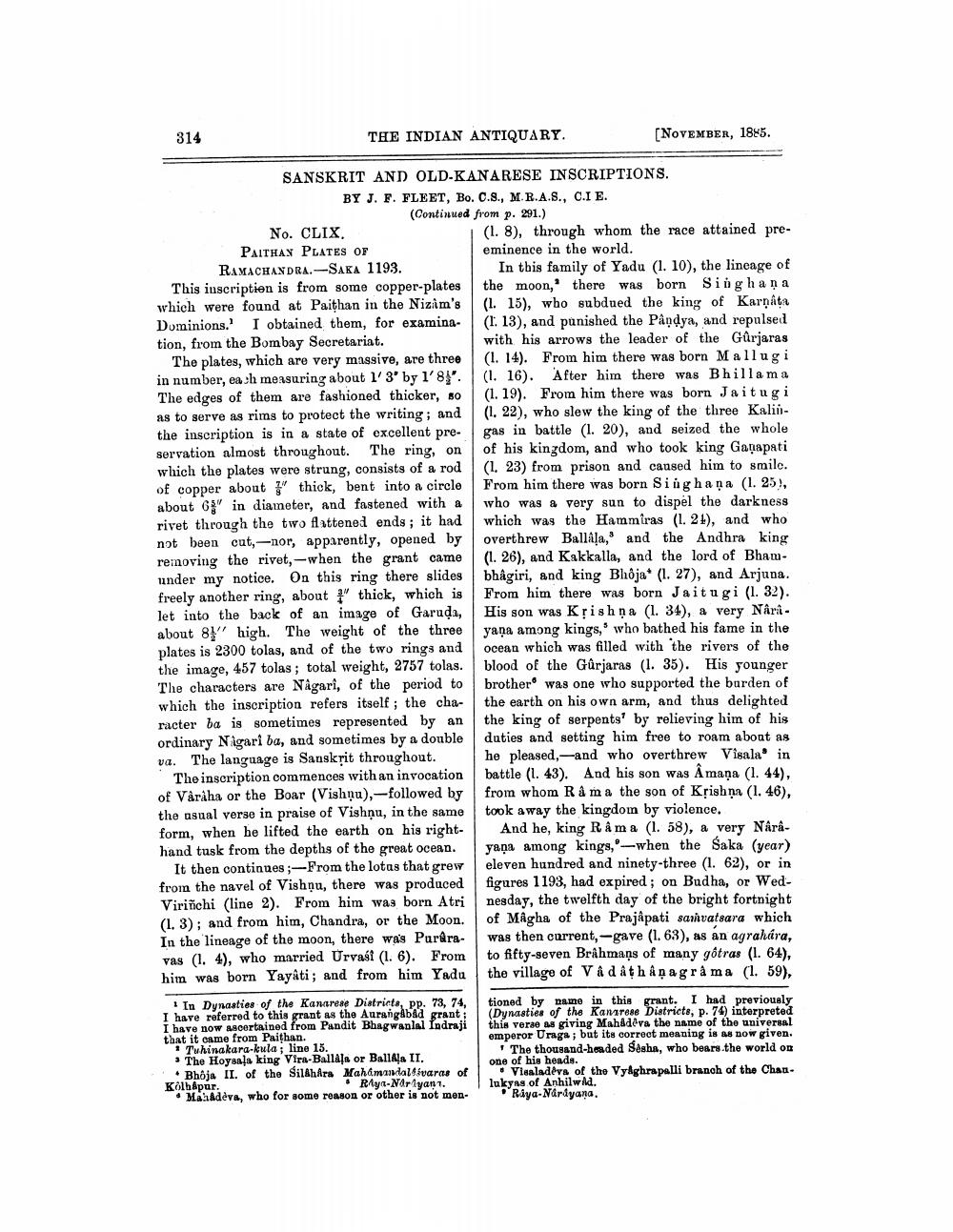________________
314
THE INDIAN ANTIQUARY.
[NOVEMBER, 1885.
SANSKRIT AND OLD-KANARESE INSCRIPTIONS. BY J. F. FLEET, Bo. C.S., M. R.A.S., C.I E.
(Continued from p. 291.) No. CLIX.
(1.8), through whom the race attained prePAITHAN PLATES OF
eminence in the world. RAMACHANDRA.-SAKA 1193.
In this family of Yadu (1. 10), the lineage of This inscription is from some copper-plates the moon, there was born Singh a na which were found at Paithan in the Nizam's (1. 15), who subdued the king of Karnata Dominions. I obtained them, for examina- (1. 13), and punished the Pandya, and repulsed tion, from the Bombay Secretariat.
with his arrows the leader of the Gurjaras The plates, which are very massive, are three (1. 14). From him there was born Mallug i in number, each measuring about 1'3' by 1'8" (1. 16). After him there was Bhillama The edges of them are fashioned thicker, 80 (1. 19). From him there was born Jaitugi as to serve as rims to protect the writing; and (1. 22), who slew the king of the three Kalinthe inscription is in a state of excellent pre- gas in battle (1. 20), and seized the whole servation almost throughout. The ring, on of his kingdom, and who took king Ganapati which the plates were strung, consists of a rod (1. 23) from prison and caused him to smile. of copper about thick, bent into a circle From him there was born Singhaņa (1.25), about 6" in diameter, and fastened with a who was a very sun to dispel the darkness rivet through the two flattened ends; it had which was the Hammiras (1.2), and who not been cut,-nor, apparently, opened by overthrew BallA!a," and the Andhra king removing the rivet, -when the grant came (1. 26), and Kakkalla, and the lord of Bhamunder my notice. On this ring there slides bhậgiri, and king Bhôja* (1. 27), and Arjuna. freely another ring, about 1" thick, which is From him there was born Jaitugi (1. 32). let into the back of an image of Garuda, His son was Kșishna (1. 34), a very Nárii. about 8}" high. The weight of the three yaņa among kings, who bathed his fame in the plates is 2300 tolas, and of the two rings and ocean which was filled with the rivers of the the image, 457 tolas; total weight, 2757 tolas. blood of the Gürjaras (1. 35). His younger The characters are Nagari, of the period to brother was one who supported the burden of which the inscription refers itself; the cha- the earth on his own arm, and thus delighted racter ba is sometimes represented by an the king of serpents' by relieving him of his ordinary Nigari ba, and sometimes by a double duties and setting him free to roam about as va. The language is Sanskrit throughout. he pleased, -and who overthrew Visala in
The inscription commences with an invocation battle (1. 43). And his son was Amaņa (1. 44), of Vârâha or the Boar (Vishnu),- followed by from whom Rama the son of Krishņa (1. 46), the asual verse in praise of Vishņu, in the same took away the kingdom by violence. form, when he lifted the earth on his right- And he, king R â ma (1. 58), a very Nárahand tusk from the depths of the great ocean. yaņa among kings,' --when the Saka (year)
It then continues ;-From the lotas that grew eleven hundred and ninety-three (1. 62), or in from the navel of Vishnu, there was produced figures 1193, had expired; on Budha, or WedVirinchi (line 2). From him was born Atri nesday, the twelfth day of the bright fortnight (1.3); and from him, Chandra, or the Moon. of Magha of the Prajapati saravatsara which In the lineage of the moon, there was Parara- was then current-gave (1. 63), as an agrahara, vas (1.4), who married Urvast (1. 6). From to fifty-seven Brahmans of many gôtras (1. 64), him was born Yayati; and from him Yadu the village of Vadath anagrama (1. 59),
In Dynasties of the Kanarese Districts, pp. 73, 74, tioned by name in this grant. I had previously I have referred to this grant as the Aurangabad krant ; (Dynasties of the Kanarees Districts, p. 74) interpreted I have now ascertained from Pandit Bhagwanlal Indraji this verae as giving Mahadeva the name of the universal that it came from Paithan.
emperor Uraga; but its correct meaning is as now given. 1 Tuhinakara-kula; line 15.
The thousand-houded Sesha, who bears the world on • The Hoysala king Vira-BallAla or BallA!a II.
one of his heads. • Bhoja II. of the Sildhira Mahamandalesvaras of • Vlaaladers of tho Vyaghrapalli branch of the Chan. Kölhapur.
• Rlyn-Nar lyan 1. lukyns of Anhilwid. • Madera, who for some reason or other is not men- Raya-Narayana.




